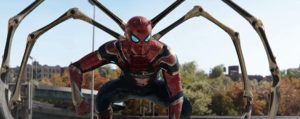Walking into AMC Georgetown on a sunny Monday afternoon, I was completely unprepared to be transported into the jaw dropping, mind-bending universe of Dune: Part Two.
This movie shook me to my core not just emotionally, but physically too. The soundscape was so thrillingly loud that at certain points I was nervous that the speakers would combust; the bass turned my seat into a massage chair. After this head-to-toe experience, I walked out of the theater and sat by the Georgetown Waterfront looking intentionally moody and contemplative. “No one will understand me anymore,” I thought. Yes, I may simply be a dramatic person, but this feeling stemmed from my surprise and disbelief at what I had just watched. I expected Dune: Part Two to just be a big-budget sci-fi flick, but oh was I wrong. It is an unquestionable powerhouse of a film that not only provoked me to further interrogate my beliefs surrounding capitalism and religion, but also reignited my appreciation for the power that the big screen holds. Centered around Timothée Chalamet’s character Paul and his ascent to power after the destruction of his family, the House of Atreides, in the last film, Dune: Part Two is, at its core, a film about politics and power plays. The gorgeous, mythic universe that it takes place in makes Paul’s journey undeniably more gripping and exciting.
Above all else, I experienced a feeling of overwhelming awe whilst watching Dune: Part Two, primarily thanks to the film’s staggering visuals and cacophonous soundscape. The scene that exemplifies this awestruck feeling is the spectacular 15 minute black-and-white battle sequence between Austin Butler’s villainous Feyd-Rautha and the remaining captives of the fallen Atreides family. Denis Villanueve’s ingenuity in choosing to shoot the montage with an infrared camera (something never done on this scale before), adds a level of uncanniness to the visuals which makes the atmosphere not just agonizingly tense but deeply disturbing. His willingness to push the boundaries of filmmaking extends to the film as a whole. While the rest may not technically be “groundbreaking” in the way that this montage was, there is an abundance of moments where one thinks “I have never seen the likes of that on a screen before.” Even before the first five minutes have passed, the shot of the Harkonnen militants floating in a line to the top of a Death Valley-esque ridge against a blazing red sun lets fans of cinematography know they are in for a visual feast. Oftentimes it is hard to comprehend the expansiveness of Arakkis’s undulating dunes, or the size and power of the famed sand worms. Villaneuve makes the Dune universe look and feel remarkably “real,” a feat which necessarily heightens the gravitas of the movie, and consequently highlights the flawless integration of CGI into the film.
As a PSA: do not be intimidated by the intense lore surrounding this franchise. Dune: Part One and this latest addition seem to be extremely faithful to the novel, to the satisfaction of those who are fans of the book. Yet for a semi-newcomer like me (I watched Dune: Part One twice but forgot most of it) all you really need to do is a quick Google of “Dune: Part 1 summary.” Or, just remember that the sandy planet Arrakis is naturally endowed with the substance “spice” that powerful Houses across the universe are competing to harvest.
At its core, there are two main themes explored in the movie. Firstly, the ruthless and power hungry fight for natural resources that occurs within a competitive capitalist framework, and secondly, and more interestingly, the dynamics and ideology of a group that hails a messiah. Even before the movie studio introductions occur, the line “he who controls the spice, controls the universe” appears on the screen. Uniting the two themes of capitalism and group ideology is an exploration of control in this film, whether that be economic, social, or regarding one’s own self.
The plot of Dune: Part Two is certainly mature and nuanced, but similarly gives into the cliched tropes of many a sci-fi fantasy film; this balance is what makes it so enjoyable. Just as you enjoy a tender moment between Zendaya’s Chani and Timothée Chalamet’s Paul, the next minute you are watching Paul learn how to ride an inconceivably large sand worm. Likewise, Florence Pugh’s Princess Irulan engages in political discourse surrounding shifts of power (extra relevant in the run up to the 2024 election) that juxtaposes the next minute’s agonizingly tense sabotage mission, abundant with explosions, combat, and nail-bitingly close calls to please that primal part of ourselves that loves to sit on the edge of our seats.
The success of the film rests on the assuredness of Denis Villenueve’s direction which unflinchingly embraces the film’s subtlety and tenderness as much as these major action sequences. Villenueve’s firm vision contrasts the lighthearted, silly tonality that pervades other action franchises such as the MCU and even Star Wars, making it hard to compare Dune to those films at all. In fact, Dune: Part Two is more comparable to the likes of Christopher Nolan’s Interstellar: both movies ignite serious existential contemplation. They make the viewer feel at once incredibly small and vulnerable while simultaneously being inspiring in their visual beauty and glimmers of hope.
Perhaps the most notable pull of the film is its star-studded cast in which every actor exceeds expectations. Timothée Chalamet is both tender and awe-inspiring in his lead performance; a fitting combination for a character who evolves from a privileged prince (of sorts) to an exile to a messiah all in under 3 hours. Sarah Ferguson’s performance is spectacular and certainly the most demanding; she becomes a possessed prophet, the “Reverend Mother” for the Fremen of southern Arrakis, and is often genuinely scary. Zendaya too is a powerhouse throughout—an unsurprising fact that comes to a riotous head in the dramatic closing shot of the film. Florence Pugh is not as present on screen as you would expect, but she delivers an elegant and powerful performance. Anya Taylor Joy is given an even harsher version of the “Zendaya treatment” from Dune: Part One, in that she shows up for a miniscule cameo, but even with only approximately 20 seconds of screen time, she exudes power and mystique. Austin Butler is almost unrecognizable with his bald, pale, and hairless appearance. He exudes horrific villainy both in his aura and his actions, and his grotesque affinity towards violence is epitomized mere seconds after his introduction. I could not tear my eyes away from him.
Fundamentally, the draw of Dune; Part Two stems from the overwhelming experience of watching it on the big screen. If you are planning on watching this film—you should be—I highly encourage you to see it in theaters while you still can. Whether you want the themed popcorn bucket is up to you. No judgment here.





